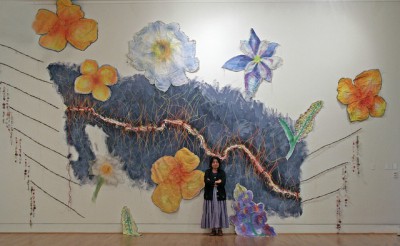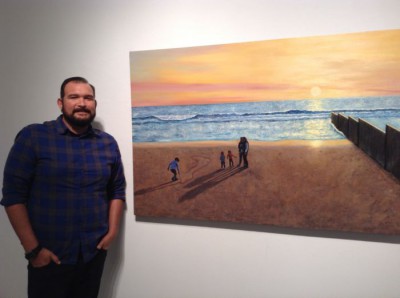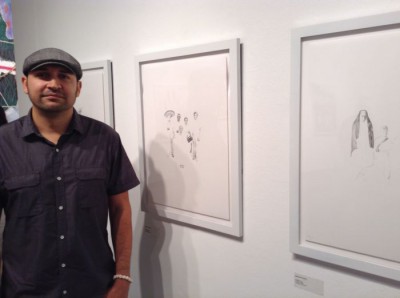
“Crossing Borders: Stories of Migration in Contemporary Art,” a new exhibit in the California State University, Dominguez Hills (CSUDH) University Art Gallery, opened Oct. 22 to packed room of artists and enthusiasts who were treated to artistic examinations centered around the U.S.-Mexico border where migrants often find themselves at odds with cultural bias and political issues.
The exhibit features paintings, prints, pencil drawings, photographs and sculptures shown through the eclectically creative minds of six artists: Los Angeles-based artists Ramiro Gomez, Nery Gabriel Lemus, Oscar Magallanes, Antonio Pelayo, Eric Almanza and San Jose pure-fiber artist Consuelo Jimenez Underwood.

The exhibit is curated by CSUDH alumnus Eric Almanza (Class of ’04, B.A., art), whose work is also on display. One of Almanza’s pieces, “In Search of a New Home,” an oil painting in the realist style, “sums up the theme of the exhibit” as is clearly depicts the desperation of an immigrant family as they attempt to scale a border wall as a helicopter circles above. Another piece “Those Things That Divide Us,” which he painted for the exhibit, was created to elicit a feeling of “futility” for border walls.
Almanza also submitted both pieces as part of his thesis show at Laguna College of Art and Design, where he recently graduated with his Master in Fine Arts degree.
“I had come across this story about extending the border wall into the Pacific Ocean by 300 feet. That inspired me for ‘Those Things That Divide Us,’” said Almanaz, who teaches art West Adams Preparatory High School in Los Angeles. “The wall is 18 feet high and extends 300 feet into the ocean, but no one seems to take notice or care about it [in the painting] as a family plays in the sand. For me, it demonstrates the futility of walls. You can’t wall up or cut people off. All they have to do is climb over or, in this case, swim around.”
“Crossing Borders: Stories of Migration in Contemporary Art” is open through December 4, 2014, during gallery viewing hours, Monday through Thursday, 10 a.m. to 4 p.m. The University Art Gallery is in room A-107 on the first floor of LaCorte Hall.
“Undocumented Border Flowers,” Underwood’s wall-sized installation in the exhibit, takes viewers on an environmentally-conscious journey by vividly expressing the destruction a border wall has, not only on people, but on the desert and its flora. She sees border regions as “wastelands” that are “symbolically trying to separate people.”
A former textile professor at San Jose State University for 20 years, Underwood is a renowned pure-thread fiber artist who is highly political in her work, which she exhibits across the United States. The flowers in “Undocumented Border Flowers” are intricately woven from linen, canvas, paper and cotton.
“On a formal level, this installation is about the materials. They are so mundane. There are paper clips, cheap jewelry, photographs; things that people really know how they feel. I want people to remember the humble materials, and know that one can make art with any mundane items or humble experiences,” explained Underwood. “More basically, this it’s about the flowers. The flowers live on both sides of the border, but they’re ‘undocumented’ and in danger of being wiped out. So this piece also represents the ecological destruction that’s taking place near the border towns, which are named in the artwork. Each side of the wall is a dead zone for about a mile. Once you create a solid dead zone across a continent, it becomes a desert.”

Pelayo, who has been an animator at The Walt Disney Company for 21 years, began exhibiting pencil-photo realism art in 2005. He had several of the delicate pencil drawings on display at the exhibit, which were drawn from images he found in his family photo albums.
He began in the genre by documenting his family’s migration from Mexico to the U.S. with a series of 13 renderings in which he redrew the photos in their entirety. Pelayo then “took it a step further” to include misplacement, identity, loss and other forms visible in his untitled series at the exhibit.
“Here I didn’t render the entire image. I took the images from my family’s photo album and switched things around, such as moving my uncle and father to different locations in the drawing. That gives the sense of feeling uncomfortable or misplaced,” said Pelayo. “In this piece, I wanted to touch on how my family is appreciative for the little things they have, which is why I’ve included the camera and the purse.”